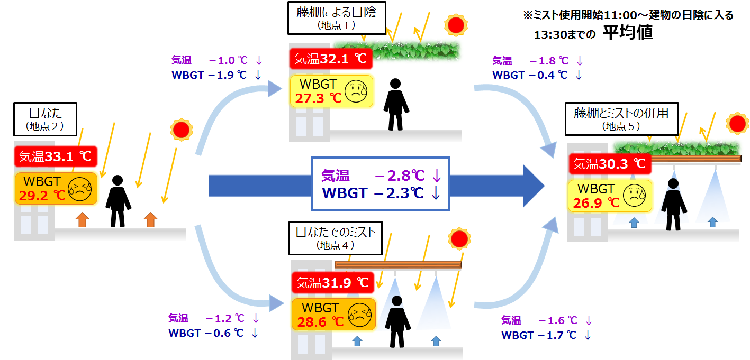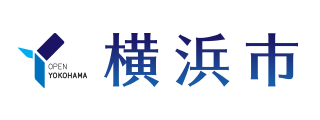Here's the text.
Heat Environment Survey
Last Updated September 27, 2024
In order to understand the current heat environment and create a comfortable space for citizens in order to adapt to heat, the Institute for Environmental Science conducts surveys on the actual conditions of heat in urban areas where many people gather and before and after the introduction of heat measures・ We verify the effects of heat mitigation by comparing places that have not introduced heat measures.
This page provides an example of a thermal environment survey.
Heat Island Countermeasures Related Page in Yokohama City
What is the Heat Island phenomenon? / Heat Island countermeasures / Temperature Observation in the City / Heat Environment Survey / Future forecast of city temperature
Results of Heat Environment Survey
About method of heat control
We conduct a thermal environment survey to verify the effects and support the spread of various heat control technologies introduced in the heat control guidelines (outside site) in the town of the Ministry of the Environment.
The method of measures against heat can be divided into four directions: "upper", "do", "yoko", and "mannaka".

Image of classification and specific examples by direction of heat control※
※Partial processing based on the “Guidelines for Measures against Heat in the Town (Ministry of the Environment, 2018)”
Green shade by trees
An old way to reduce solar radiation from the "Upper" direction is the shade of trees.
By planting trees with large crowns in rest spaces and walking spaces, the shade of greenery is formed and sunlight is blocked, which has the effect of reducing the perceived temperature.
Heat Environment Survey in Grand Mall Park
In Grand Mall Park, located in the Minatomirai district of Yokohama, where the park was redeveloped.
A comparative survey was conducted in the summer of 2014 before redevelopment and in the summer of 2018 after redevelopment.
Compared to before the redevelopment, it was confirmed that the effect of increasing greenery and forming a large shade of green has reduced the temperature and surface temperature, and that the summer heat environment has been eased.

Infrared images before and after the redevelopment of the park
Artificial sunshade
One of the ways to reduce solar radiation from the "Upper" direction is artificial shades such as eaves and tents.
One of the artificial sunshades is called "Fractal sunshades", which is a sunshades that prevents the sunshades from getting hot by imitating the shape of the leaves of trees and increasing heat dissipation characteristics.
Heat Environment Survey in Aka Renga Soko
Fractal sunshades, which are said to have a higher effect on heat control than conventional artificial sunshades, are said to be effective in controlling heat.
To verify this effect, we conducted a thermal environment survey in Aka Renga Soko in the summer of 2016.
As a result of the survey, it was confirmed that the solar radiation, temperature, surface temperature, etc. were lower under the sunshade compared to the sunshade.

Visible and infrared images of fractal sunshade
Survey of heat control effects using fractal sunshades in Aka Renga Soko (PDF: 2,196KB)
Recursive reflection of windows, etc.
The solar radiation from the direction of "Upper" is reflected not only from solar radiation, but also from surrounding buildings and other buildings.
There is also solar radiation that reaches the ground surface. As a method of suppressing solar radiation that reflects and reaches the ground, there is a recursive reflection on windows and other surfaces.
The "heat ray regression film", which incorporates a method of regression reflection, uses a special film to attach a special film to the windows of the building to reflect a part of the solar radiation hitting the window in the sky, suppressing the deterioration of the heat environment for pedestrians.
Heat environment survey at elementary schools

Measurement at elementary school
In the summer of 2017, the Institute for Environmental Science conducted a demonstration experiment using public facilities.
In addition to reducing the heat environment in the room, it was confirmed that the re-reflective film did not deteriorate the outdoor heat environment.
The efforts of the research of "Fractal sunshades" and "heat ray regression film" conducted by the Institute of Environmental Science were also introduced at the National Institute for Environmental Studies (A-PLAT) (external site).
Heat shielding of ground surfaces
As a countermeasure against heat in the direction of "has been done", there is a heat shielding that suppresses the high temperature of the ground surface.
One example of the heat shielding of the ground surface is "thermal shielding pavement".
Heat-shielding pavement suppresses the rise in road surface temperature by applying heat-shielding materials that reflect solar radiation to the pavement surface, reflecting part of the solar radiation and reducing the heat absorbed to the road surface.
Heat environment survey on heat shielding pavement
The Institute for Environmental Science conducted a survey on heat-inserted pavement and on normal pavement, which were enforced on roads in the city in the summer of 2016.
As a result of the survey, it was confirmed that during the day, the surface temperature of the heat-insulating pavement was about 10 ° C lower than that of normal pavement during the day, resulting in the effect of mitigating the heat environment of pedestrians during the day.

Infrared images of normal pavement and thermal insulation pavement
Cooling with micromist

Mechanism of cooling by mist
As a measure against heat in the middle, there is a measure to prevent heat from accumulating in the body by cooling the air around people. One example is "fine mist".
Fine mist is a method of spraying mist-like water droplets into the air from the nozzle and using the heat of vaporization as soon as the water droplets evaporate to reduce the temperature locally.
Heat environmental survey on mist cooling
In the summer of 2019, we investigated the cooling effect of the mist installed in Fujidana along the sidewalk in front of the Isogo Ward Office.
Compared to the sun, even with the mist alone, improvements in the perceived temperature, such as WBGT, which indicates the danger of heat stroke, were seen.
Furthermore, in places combining mist and Fujidana shade, the WBGT and other sensational temperatures have been improved most, and by combining them efficiently with shade, it can be expected to further mitigate the heat environment.

Summary of Mist Cooling Effect
For details of the survey results, please see pages 50-57 of Yokohama City Institute of Environmental Science Bulletin No. 45.
Related links (outside site)
Ministry of the Environment "Revised Guidelines for Heat Measures in the Town" (outside site)
You may need a separate PDF reader to open a PDF file.
If you do not have it, you can download it free of charge from Adobe.
![]() To download Adobe Acrobat Reader DC
To download Adobe Acrobat Reader DC
Inquiries to this page
Environmental Science Research Institute, Environmental Conservation Department, Green Environment Bureau
Telephone: 045-453-2550
Telephone: 045-453-2550
Fax: 045-453-2560
Email address: mk-kanken@city.yokohama.lg.jp
Page ID: 835-811-328







